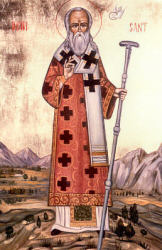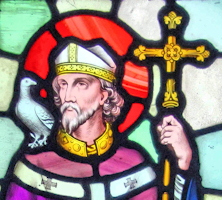Lent: March 1st
Wednesday of the First Week of Lent; Ember Wednesday of Lent
Other Commemorations: St. David of Wales (RM; Feast, Wales and England)
» Enjoy our Liturgical Seasons series of e-books!
Today is Ember Wednesday, the beginning of the Spring or Lent Embertide. There are two principal objects for the Ember Days of this period of the year: the first is to offer to God the season of Spring, and, by fasting and prayer, to draw down His blessing upon it; the second is to ask Him to enrich with His choicest graces the priests and sacred ministers who are to receive their Ordination on Saturday. See also Contemporary Observation of Ember Days and Lenten Ember Days for more information.
The Roman Martyrology commemorates St. David (542-601), Bishop and patron of Wales. The Church in Wales and England celebrates this saint as a Feast. Very little is known about the life of St. David (Dewi Sant). He belonged to that great monastic movement which became influential in Wales in the sixth century and which had links with monasticism in Gaul and in Ireland. The earliest references to David are in the Irish Annals. Many churches across South Wales claim David as their founder. His chief foundation was at Mynyw or Menevia in Dyfed. He was canonized by Pope Callistus II in 1123.
Meditation on the Liturgy
The people of Nineveh are also our model for Lent. They did penance at the preaching of Jonah the prophet and obtained divine mercy and pardon. Christ is preaching penance to use today through his Church. Should we not also put on the sackcloth of self-denial and take on the fast to remedy our self-indulgence that we also may obtain forgiveness for ourselves? Nor should we forget to pray for a world which is drowning in the sin and vice of its own creation.
Before we arrive at the joy and glory of Easter we have first to go through forty days of Lenten journey. This period of preparation is designed by God. It is not merely a time of self-denial, of death to self, and of carrying the cross; it is a time of recovery of our real self, of a more real life, and of sharing in Christ's glory. God intends that we should accustom ourselves to live the Paschal rhythm of "death and life" to reclaim one's real self and to become ready to share in Christ's glory.
—St. Andrew Bible Missal
Lent Ember Days or Lent Embertide, Ember Wednesday of Lent
The Church has traditionally designated Wednesday, Friday and Saturday of the First Week in Lent during which to consecrate the season of spring to God and to obtain graces, through prayer, fasting and the offering of the holy Sacrifice. These days, however, unlike those of the other seasons, do not refer to the fruits of the earth, but are rather expiatory in character.
The Lenten Ember days are the most recent of the four sets of Ember Days and do not have the same importance as the other three, since the whole of Lent is devoted to spiritual renewal. Doubtlessly the three days, Wednesday, Friday and Saturday, formed part of the Lenten liturgy from its very beginning. Wednesday, devoted to our Lady, is a day of reflection and spiritual orientation; Friday emphasizes conversion and penance; Saturday, a preview of Easter, marked the renewal of our baptismal covenant.
On all four Ember Wednesdays the stational service was observed in the largest church of our Lady in Rome, St. Mary Major. This basilica, which dates from the fourth century, was rebuilt by Pope Sixtus III (431-440), and dedicated to our Blessed Mother as a result of the Council of Ephesus' definition of the divine motherhood of the Virgin Mary.
It is probable that in the second half of the fourth century the Ember day observance was rearranged and the three great churches (St. Mary Major, Holy Apostles, St. Peter) were selected as stations.
Today, then, we pilgrimage to the largest and most venerable shrine of Our Lady in the world and honor the Mother of God as our patron. The humble guise in which we meet her in the Gospel serves as a model for Lenten humility. Nevertheless, we are promised a participation in her dignity, i.e., we are destined to become "mothers and brothers to Jesus," if we do "the will of His Father." Thus Mary is our companion during Lent. Devoutly and suppliantly we enter the stational church, reminding God of His never failing mercy and begging for liberation from oppression. The kingdom of God never lacks enemies.
"The men of Nineveh [the pagans] shall rise in judgment with this generation [the chosen people of Israel] and shall condemn it; because they did penance at the preaching of Jonah; and behold a greater than Jonah here. The queen of the South [of Saba] shall rise in judgement with this generation and shall condemn it; because she came from the ends of the earth to hear the wisdom of Solomon; and behold a great then Solomon here." The chosen people would have nothing to do with their Savior when He came to them. They rejected Him, and therefore they themselves were rejected. We who are of the Gentiles have been chosen in their place. Mary and our Holy Mother the Church lead us to Him. In baptism we were made His brothers and sisters and were joined to Him in a union of prayer, in a union of life and spirit. From that moment we are bound to do the will of the Father.
We can prove unfaithful to our vocation, lose our faith, and fall away. For this reason the Church presses upon us the urgency of self-examination, penance, and meditation during the holy season of Lent, for the "men of Nineveh did penance at the preaching of Jonah" and thus found favor with God.
Our hearts are filled with gratitude for the great grace that has been given to us in baptism. We should renew our desire and our resolution to accomplish the will of the Father. "I will meditate on Thy commandments which I have loved exceedingly; and I will lift up my hands to Thy commandments which I have loved."
—adapted from Dom Rembert Bularzik, O.S.B, Orate Fratres, Pius Parsch, OSB, The Church's Year of Grace and Benedict Baur, The Light of the World
St. David of Wales
 All the information we have about David is based on the unreliable eleventh-century biography written by Rhygyfarch, the son of Bishop Sulien of St. David's. According to it David was the son of King Sant of South Wales and St. Non, became a priest, studied under St. Paulinus on an unidentified island for several years, and then engaged in missionary activities, founding some dozen monasteries, the last of which, at Mynyw (Menevia) in southwestern Wales, was noted for the extreme asceticism of its rule, which was based on that of the Egyptian monks. David attended a synod at Brefi, Cardiganshire, in about 550 where his eloquence is said to have caused him to be elected primate of the Cambrian Church with the understanding that the episcopal see would be moved from Caerleon to Mynyw, now St. David's. He was supposedly consecrated archbishop by the patriarch of Jerusalem while on pilgrimage to the Holy Land, and a council he convened, called the Synod of Victory because it marked the final demise of Pelagianism, ratified the edicts of Brefi, and drew up regulations for the British Church. He died at his monastery at Mynyw, and his cult was reputedly approved by Pope Callistus II about 1120. Even his birth and death dates are uncertain, ranging from c. 454 to 520 for the former and from 560 to 601 for the latter.
All the information we have about David is based on the unreliable eleventh-century biography written by Rhygyfarch, the son of Bishop Sulien of St. David's. According to it David was the son of King Sant of South Wales and St. Non, became a priest, studied under St. Paulinus on an unidentified island for several years, and then engaged in missionary activities, founding some dozen monasteries, the last of which, at Mynyw (Menevia) in southwestern Wales, was noted for the extreme asceticism of its rule, which was based on that of the Egyptian monks. David attended a synod at Brefi, Cardiganshire, in about 550 where his eloquence is said to have caused him to be elected primate of the Cambrian Church with the understanding that the episcopal see would be moved from Caerleon to Mynyw, now St. David's. He was supposedly consecrated archbishop by the patriarch of Jerusalem while on pilgrimage to the Holy Land, and a council he convened, called the Synod of Victory because it marked the final demise of Pelagianism, ratified the edicts of Brefi, and drew up regulations for the British Church. He died at his monastery at Mynyw, and his cult was reputedly approved by Pope Callistus II about 1120. Even his birth and death dates are uncertain, ranging from c. 454 to 520 for the former and from 560 to 601 for the latter.
—Excerpted from Dictionary of Saints, John J. Delaney
Patronage: doves; Wales
Symbols and Representation: leek; dove; daffodil; Celtic bishop with long hair, beard and dove on shoulder; bishop holding cathedral; preaching on a hill; man standing on a mound with a dove on his shoulder
Highlights and Things to Do:
- Read more about St. David:
- Find out more about the Welsh customs surrounding this day here and here.
- St. David was buried in St. David's Cathedral in Pembrokeshire, Wales. From Wiki: "His shrine was a popular place of pilgrimage throughout the Middle Ages. During the 10th and 11th centuries the Cathedral was regularly raided by Vikings, who removed the shrine from the church and stripped off the precious metal adornments. In 1275 a new shrine was constructed, the ruined base of which remains to this day, which was originally surmounted by an ornamental wooden canopy with murals of David, Patrick and Denis. The relics of David and Justinian of Ramsey Island were kept in a portable casket on the stone base of the shrine. It was at this shrine that Edward I came to pray in 1284. During the reformation Bishop Barlow (1536–48), a staunch Protestant, stripped the shrine of its jewels and confiscated the relics of David and Justinian."
- So often the celebrations forget the historical and religious contributions of St. David. Read this 16 things you (probably) didn’t know about St David’s Day traditions.
- Leeks and daffodils are visually prominent in this day. Cook something with leeks, and decorate with the sign of spring--beautiful yellow daffodils.
- See Catholic Cuisine for some food ideas for St. David's Day.






